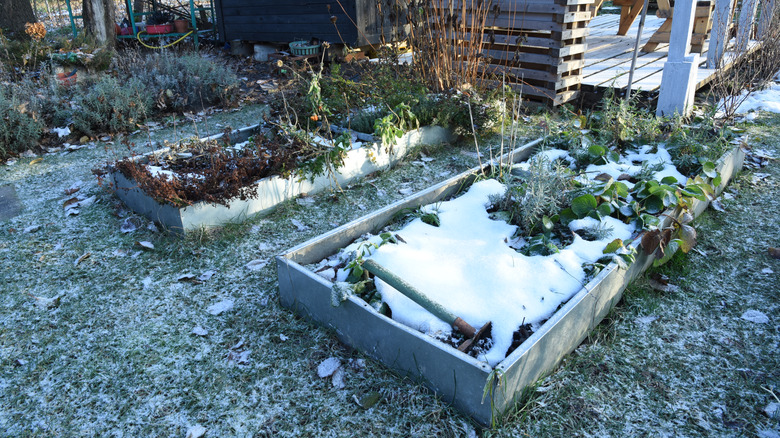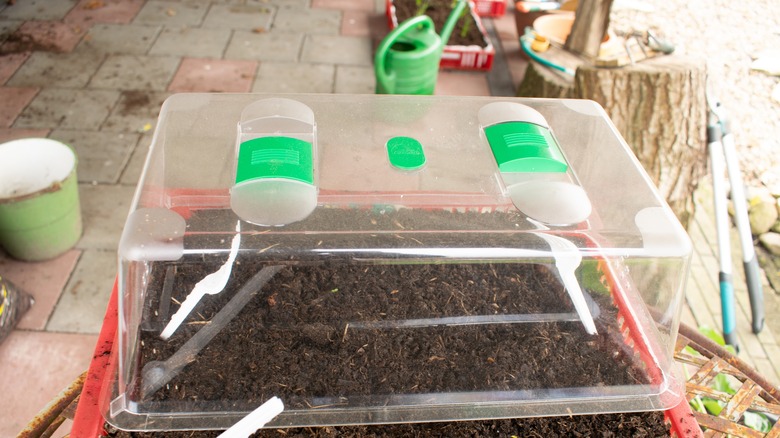Extend The Growing Season In Your Garden With This Easy Container Hack
If fall and winter are on their way, you can say goodbye to those summer harvests. Right? Wrong! You can get a few more weeks out of Mediterranean herbs and warm-season vegetables like compact bush tomatoes, spinach, and peppery arugula by simply popping a tote over your plants. After all, plastic totes are often used as mini greenhouses, so it's not a stretch to imagine they can also be useful turned upside down in a garden bed. Get your hands on a large transparent plastic container, either by purchasing it new or sourcing it secondhand. Drill a decent number of holes around the top for ventilation. Pop the whole thing over seedlings or plants vulnerable to chilly weather and pests, and watch them thrive far later into the colder months than you imagined they could. What you've created with this cheap storage box is, essentially, a highly portable cold frame.
So, what is cold frame gardening? And is that really what you're doing with this hack? Gardeners who know cold weather or frost is about to descend on their garden will pop a cold frame — essentially, a box made of plastic, wood, or other solid materials with a clear lid — over their beds. Similar systems include poly-tunnels and frames draped in flexible, waterproof, insulating materials like plastic sheeting or landscaping fabric. This tote DIY could also be compared to an upscaled version of cloches and hot caps — plastic or, traditionally, glass domes that fit over individual plants.
The good and the bad of using plastic containers as season extenders
This clever way to reuse your plastic containers in your garden works similarly to a DIY cold frame or cloche. Place a clear plastic tote over tender seedlings in a garden bed, and it will trap heat from the soil and raise humidity inside the covered area while creating a barrier against frost, wind, rain, and snow. Gardeners can nurture summer plants along for longer, even as outside temperatures drop. When YouTuber and farmer Jag Singh from Daisy Creek Farms experimented with a plastic storage container as a cold frame, he found temperatures were over 20 degrees Fahrenheit higher inside the tote than out. What's more, these containers are lightweight, making them easy to lift and move, waterproof and sturdy (even holding up under heavy snow), and stackable for easy storage when not in use.
It's not all positive, however. There's also the issue of whether plastic is a good option for your garden at all. If the plastic touches a plant's leaves, the trapped moisture and reduced insulation leads to frost damage. This, however, is mostly an issue with plastic sheets draped over branches. Solve this problem by leaving at least a few inches of space between your plants and the sides and top of the plastic container. It's quite possible, too, that a container made of thin plastic simply doesn't offer enough of an insulating barrier to protect the plants inside.
Crafting and using a plastic container cold frame in your garden
Plastic isn't breathable; an unvented container can heat up a lot in sunny weather, hold too much moisture, and encourage softer, less cold-hardy plant growth. Pests, like snails and slugs, and fungal diseases thrive in the humidity and warmth, and weeds grow more easily. Covering fruit- or seed-bearing plants at the wrong time means insects can't reach the flowers, thwarting much-needed pollination. Thankfully, all of these issues have simple solutions, so long as you reuse plastic storage totes to DIY a chic, non-permanent garden bed cover the right way.
Walk around your garden and take note of the plants you want to protect or get greater longevity from, be it herbs or vegetables in garden beds or even in containers. Measure the height, width, and length of these plots. If you don't have a tote at home, shop at low-cost big box retailers with plastic tubs in a wide range of sizes — think The Container Store, Target, and Lowe's. Drill a handful of holes along the bottom sides of the container, providing much-needed ventilation to prevent the aforementioned overheating and moisture build-up. Then, flip the container upside down directly onto the soil in your garden bed, allowing it to sink slightly into the ground. If you're expecting frosts, pile mulch around the edges of the tote, cover it with old blankets, or place (waterproof) a string of Christmas lights inside for added insulation and warmth.

